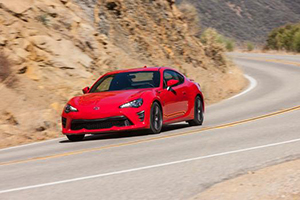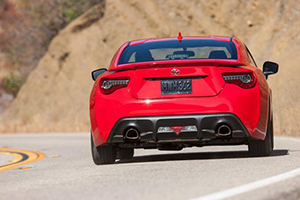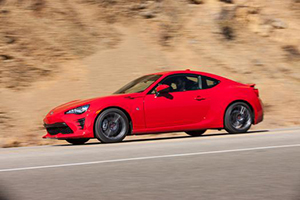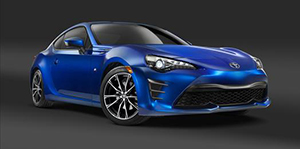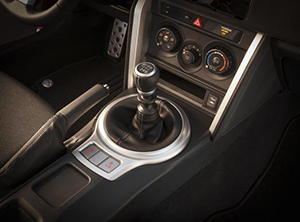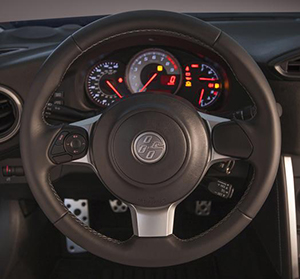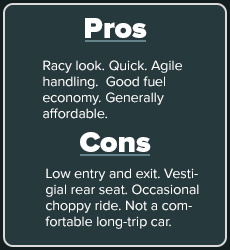2017 Toyota 86
The Toyota 86 is for
genuine sports car lovers
Prices: $26,255-$26,975
Toyota has dropped its Scion division, so the 2017 Toyota 86 is a
slightly improved version of last year's Scion FR-S, partly developed
with Subaru.
Why call the new Toyota model the "86?" Because "AE86" was the global
name for the hot little Toyota Corolla GT-S sold here in the
mid-1980s. In Japan, it was known as the "hachi-roku," meaning "8-6."
Now, that's definitely not a name that would play in America.
"Toyota 86" still seems like a curious name for the U.S. market, but
there you have it. Still, what's in a name? The Toyota 86, like the
generally applauded Scion FR-S, is a combination of style, performance,
handling and affordability that have made it generally popular with
sports car enthusiasts.
Compared to the FR-S, The 86 has more aggressive styling with a larger
center intake emphasizing the car's low, wide stance. The front has a
new design with standard LED front headlights, daytime running lights
and turn signals, a new fog lamp bezel and a revised bumper. However,
the front end is very low.
The rear has LED tailights and a more sculpted bumper design with an
integrated aerodynamic diffuser and two sporty looking exhaust pipe
outlets. Alloy wheels have a new "twisted" spoke design.
The quiet interior has a new "Granlux" material used on the instrument
panel surround. That material adds a soft feel to door trim. There's
also new seating material with silver stitching, also found in the
cabin, and a thick, revised steering wheel with integrated audio
controls.
Gauges are generally easy to read, although sunlight washes some out.
At least there's a large center-mounted tachometer that integrates a
digital speedometer. It's flanked on the left by an analog speedometer.
Sun visors swivel to the side to block sunlight from driver's eyes.
So far, so good. But this is a very low car with long, heavy doors and
a cabin that requires a "fall in-climb out" technique. The front bucket
seats offer lots of support, but the tight rear seat is for children or
added cargo when the rear seatback is folded forward. Cargo space with
the rear seat in its upright position is decent for a small sports car.
My test car's ignition key seemed old-fashioned, compared to a
pushbutton starter now found in many cars. But controls were easy to
use. The Display Audio features a 7-inch touchscreen display, which
integrates the rearview camera and such things as an 8-speaker Pioneer
audio system.
The 86 was fairly well-equipped, with such items as air conditioning,
power windows, locks and remote keyless entry.
An optional 86 Display Audio with a navigation system features
push-to-talk voice navigation and geo-located points of interest.
Safety features include anti-lock brakes, traction and vehicle
stability control and Smart Stop technology. There are numerous air
bags and side curtains. Rear seats can accommodate front-facing child
seats.
This car is quick, partly because it's among the lightest
sports car sold, at 2,758 pounds. A driver can select a "sport mode,"
which makes gears change at higher engine r.p.m.s.
The 86's 2-liter aluminum boxer (horizontally opposed pistons) engine
from Subaru delivers 205 horsepower, up from 200, for the slick $26,255
six-speed manual transmission version. Horsepower is unchanged at 200
for the responsive six-speed automatic version, which has paddle
shifters and lists at $26,975.
I like shifting gears, but found the automatic was a blessing in heavy
traffic. The high-revving engine gets noisy during hard acceleration,
but delivers estimated fuel economy with the automatic of 24 city and
32 highway. The numbers are 24 and 28 with the manual.
Premium fuel is called for.
The quick electric power steering is almost track-like, with 2.48 turns
lock-to-lock. The turning circle is a tight 36.1 feet. Handling is
exceptional, and the brake pedal has a linear action. There's revised
shock tuning and a spring rate change for enhanced control and more
agile performance.
The 86 has a rear-drive sports car platform with a MacPherson strut
front suspension and, notably, a double-wishbone rear suspension.
However, some road imperfections and raised highway expansion strips
cause the ride to be too bumpy for comfortable long-distance trips.
Still, recalling some classic sports cars I've owned, an occasional
bumpy ride was just part of the deal.

